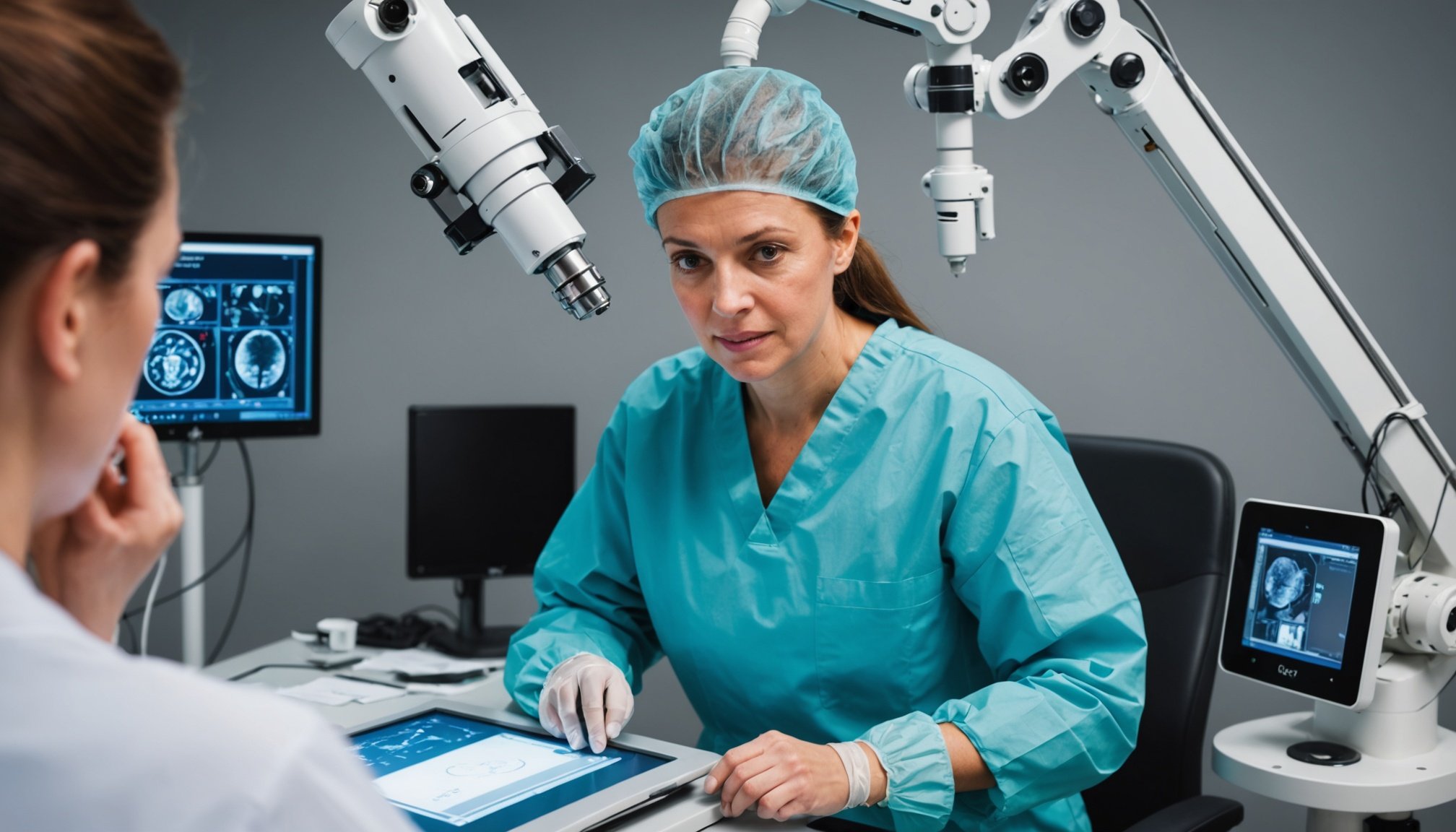Overview of Robotic Surgery in Gynecology
Robotic Surgery has transformed the field of Gynecology with its groundbreaking Advancements. Historically, gynecological procedures were predominantly performed via open surgery, which involved significant recovery time. With the advent of minimally invasive techniques, Robotic Surgery emerged as a revolutionary solution, offering precision and reduced patient trauma. This technology has evolved rapidly, with the first robotic-assisted hysterectomy performed in the early 2000s.
In the UK, Robotic Surgery in Gynecology reflects a positive trend, with a notable increase in procedures performed annually. Recent statistics highlight that over 60% of complex gynecological surgeries now incorporate robotic techniques, highlighting their growing acceptance and trust among healthcare providers and patients alike.
Also to read : Enhancing Prostate Cancer Patient Follow-Up: The Role of Telemedicine for UK Urologists
Different robotic systems are employed in gynecological procedures. The da Vinci system is one of the most prevalent, renowned for its intricate capabilities, allowing surgeons to perform delicate and precise movements. Another system gaining traction is the Versius robotic platform, designed to offer versatility and ergonomic benefits. These systems have redefined surgical disciplines, contributing substantially to improving patient outcomes.
Through these Advancements in robotic technology, the landscape of Gynecology continues to evolve, making surgery safer, more effective, and less intrusive for women globally.
Also to read : Exploring Innovative Techniques in Peritoneal Dialysis by Leading UK Nephrologists
Latest Technologies in Robotic Surgery
In recent years, robotic technology has transformed the surgical landscape, providing unparalleled precision and safety. Surgical systems like the da Vinci and Versius exemplify this innovation through their cutting-edge features, including robotic arms with highly flexible movements and 3D high-definition visual interfaces. These features enable surgeons to perform complex procedures with improved accuracy and dexterity compared to traditional methods.
Advancements in technology contribute significantly to enhanced surgical precision, reducing the likelihood of human error. Additionally, by offering less invasive options, these systems facilitate faster recovery for patients, minimizing postoperative complications and reducing hospital stays.
Emerging technologies in robotic surgery promise to further this innovation, with developments such as AI integration and real-time data analytics paving the way for precision that was once unimaginable. This ongoing evolution is poised to have a profound impact, potentially streamlining surgeries and fostering increased operational efficiency.
In summary, innovations in robotic technology continue to redefine the boundaries of surgical capability. As these surgical systems progress, their role in improving patient outcomes and surgical success rates becomes increasingly significant, heralding a new era of medical intervention.
Benefits of Robotic Surgery for Gynecological Procedures
Robotic surgery in gynecology offers numerous surgical benefits, which significantly enhance patient outcomes. One major advantage is the reduced hospital stay. Unlike traditional surgery, which often requires extensive in-hospital recovery, minimally invasive robotic procedures generally allow patients to return home sooner, contributing to both physical and emotional wellbeing. Additionally, quicker recovery times are a key feature of robotic techniques.
Patients undergoing minimally invasive surgery typically experience faster healing and less post-operative discomfort, leading to increased patient satisfaction. This satisfaction stems from not only reduced pain but also from the minimal scarring associated with robotic incisions. Many patients prefer minimally invasive surgery due to these aesthetic and post-operative benefits.
Moreover, robotic surgery has the potential to result in fewer complications, such as infections and bleeding, compared to traditional methods. This advantage contributes to lower morbidity rates, presenting a significant surgical benefit for patients. With these improvements, patient outcomes are consistently enhanced, supporting the continued adoption of robotic techniques in gynecological procedures. By embracing robotic surgery, the healthcare sector moves towards a future where patient outcomes are prioritized above all else, ensuring better overall care and recovery experiences.
Case Studies: Successful Implementation of Robotic Surgery
Gynecological surgery stands out in many case studies showcasing the triumph of robotic surgery. The success rates in these studies are impressive, underscoring robotic surgery’s effectiveness. One example involves a hospital where robotic systems facilitated complex hysterectomies with precision and minimal invasiveness, leading to faster recovery times.
Feedback from surgeons highlights the enhanced dexterity and precision robots provide during these procedures. Surgeons report that robotic tools allow them to perform intricate operations with improved vision and control, resulting in fewer complications. Patients, too, experience significant benefits, such as reduced pain and quicker discharge from the hospital.
Several factors contributing to successful implementation emerge from these studies. Proper training for surgical teams is paramount, ensuring they are well-versed in robotic system operations. Additionally, strong hospital support and advanced facilities foster optimal outcomes.
By focusing on these factors, hospitals can increase their success rates in robotic surgeries, particularly in gynecological contexts. When done right, robotic surgery not only transforms surgical procedures but also enhances patient experiences, making it a win-win for all involved.
Expert Insights: Interviews with Leading Surgeons
Amidst the surge of robotic surgery, certain key expert opinions have emerged, providing clarity to the medical field. Esteemed gynecological surgeons are at the forefront, sharing valuable insights and experiences. Their input is pivotal for hospitals and clinics contemplating this technological transition.
Prominent surgeon interviews reveal that robotic systems offer precision, leading to reduced recovery times for patients. This advancement is shifting hospital strategies, highlighting the need for investment in state-of-the-art facilities and training programs for surgeons.
Market trends suggest a promising future for robotic surgery. The growing demand and technological enhancements forecast a steady expansion in this domain. Surgeons predict an increase in the adoption of robotic procedures, with innovations continuously refining the tools and techniques used.
For hospitals and clinics, the recommendations are clear. Investing in these systems will enhance service quality and patient outcomes. It is crucial to incorporate structured training programs and regularly update toolsets to remain competitive. By heeding these insights, healthcare institutions can navigate the evolving landscape efficiently and effectively. This proactive approach ensures alignment with future market trends and expert opinions in robotic surgery.
Training and Certification for Surgeons
The journey toward mastering robotic surgery requires comprehensive surgical training. Various programs are available, focusing on imparting the necessary skills and knowledge. These programs often combine theoretical instruction with practical hands-on experience. The integration of both methods ensures surgeons can navigate complex procedures efficiently.
Simulation training plays a pivotal role in surgeon education. It offers a safe environment to practice different scenarios without patient risk—enabling trainees to hone technical skills and improve decision-making. Simulators replicate real surgeries, allowing surgeons to develop confidence and proficiency before engaging in live operations.
Attaining certification is crucial in the medical profession. It signifies that a surgeon has met specific standards and is competent in robotic surgery techniques. Certification involves a rigorous evaluation of skills and may require passing comprehensive exams that test both theoretical knowledge and practical abilities.
Continuous professional development is equally important. The dynamic field of robotic surgery necessitates surgeons to stay updated with the latest technological advancements and surgical techniques. Engaging in regular workshops, seminars, and further training sessions ensures that practitioners can continually refine their expertise and deliver the highest care quality. Certification renewal may also require proof of ongoing education and practice refinement.
Regulatory Considerations in the UK
Regulating robotic surgery compliance in the UK involves multiple bodies ensuring safe and effective healthcare. The Medicines and Healthcare products Regulatory Agency (MHRA) plays a pivotal role, overseeing the safety standards and regulatory approvals of robotic devices used in surgical procedures. Such regulation helps maintain high standards for patient safety and device efficacy.
Designed to protect both patients and practitioners, the UK guidelines require rigorous testing and quality assurance of robotic surgery systems. These guidelines necessitate detailed risk assessments and evidence of safety and performance before adoption in clinical settings. Hospitals and medical professionals must adhere to these rules and incorporate technology only approved by the MHRA.
However, despite these safety measures, regulatory compliance can sometimes slow down the adoption of robotic surgery. The complexities of meeting regulatory standards mean longer times before innovative technologies can be employed. Yet, the impact of these guidelines on health systems is ultimately positive. They guarantee each robotic system introduced into healthcare is of the highest quality and provides a viable, safe option for surgical procedures. As this technology evolves, regulations will continue to adapt, aiming for an optimal balance between innovation and patient safety.
Practical Guidelines for Implementation
Implementing robotic surgery systems in hospitals requires strategic planning and execution to ensure efficacy and acceptability. Firstly, hospital management should adopt a detailed integration framework. This framework must highlight thorough evaluation of existing infrastructure and identify necessary alterations for the seamless incorporation of robotic systems.
To mitigate cost-related concerns, it is crucial to consider various funding options. Hospitals can explore government grants, private investors, or leasing models that allow gradual financial outlay. It’s vital to weigh upfront investments against long-term savings afforded by reduced procedural complexities and shorter recovery times for patients.
When engaging staff, a multi-faceted approach is essential. Training programs led by specialists in robotic systems should be implemented, ensuring that surgical teams are proficient in these advanced technologies. Furthermore, by fostering a culture of acceptance and enthusiasm towards technological advances, hospitals can enhance their operational efficacy.
Preparation for patients is another critical aspect. Educating them about the benefits and potential outcomes of robotic procedures can aid in alleviating apprehensions. Clear communication and information sessions will allow patients to make informed decisions about their healthcare.
Implementing these strategies not only promises smoother integration but also elevates the quality of surgical care provided.
Conclusion on Patient Outcomes and Future Trends
Robotic surgery greatly influences patient outcomes, revolutionising healthcare in the UK. The precision and minimally invasive nature of robotic systems often lead to quicker recovery times and reduced risk of complications compared to traditional surgeries. These factors uniquely contribute to improving overall patient satisfaction and long-term health results.
Looking to the future of surgery, there’s a rising anticipation for advancements in robotic innovations. Emerging technologies, such as artificial intelligence (AI) integration, have the potential to further refine surgical accuracy and outcomes. AI-enabled robots could assist in decision-making processes, helping surgeons identify the optimal surgical path or anticipate potential risks more effectively.
In the field of gynecological surgery, the adoption of these innovations is likely to transform practices extensively. As expertise grows and technologies become more sophisticated, the procedures may become even less invasive, enhancing the quality of life for patients.
The impact on the healthcare landscape throughout the UK could be significant. Not only would surgical practices evolve, but there could also be a reduction in hospital stays and healthcare costs. This modernisation encourages continued development and investments, ensuring the UK healthcare system remains at the forefront of medical excellence.











